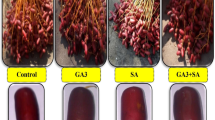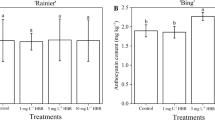Abstract
Plant growth regulators play a vital role in fruit growth and development. However, effects of compounds belonging to the group of brassinosteroids have not been fully investigated in sweet cherries. One relatively new and one commonly applied growth regulator, 22S, 23S-Homobrassinolide and GA3, respectively, were tested on ‘Summit’ and ‘Regina’ sweet cherries to determine the effects on fruit quality and physiological disorders. The substances were applied with a handgun sprayer at full bloom and at the beginning of fruit development (shuck split) for a 2-year period. GA3 was applied at the concentrations of 25, 50, 100 mgL−1 and 22S, 23S-Homobrassinolide at 0.05, 0.1, 0.5 mgL−1. A combined application of 100 mgL−1 GA3 + 0.1 mgL−1 22S, 23S-Homobrassinolide was also applied. Effects of GA3 and 22S, 23S-Homobrassinolide on fruit weight and size were evident for the concentrations applied and between the seasons for both of the cultivars. Combination of the both growth regulators and 100 mgL−1 GA3 alone produced longer fruits compared to the control trees in ‘Regina’. The 22S, 23S-Homobrassinolide applications increased the firmness of the flesh slightly, but not to a great degree, compared to the GA3 applications alone. The brightness of the red color was better with GA3 applications in ‘Summit’ and ‘Regina’. Brassinosteroid caused the fruits to have comparably dull red color. Total soluble solid contents of the cultivars were influenced by the substances and the year of the application. Stem resistance to separation from the fruit was under the influence of both treatments and seasons. In general, 22S, 23S-Homobrassinolide provided better stem resistance than the GA3 applications. There were no effects of the substances on the development of physiological disorders.
Zusammenfassung
Pflanzenwachstumsregulatoren spielen eine wesentliche Rolle bei Fruchtwachstum und Fruchtentwicklung. Allerdings sind die Einflüsse der Wirkstoffe, die zur Gruppe der Brassinosteroiden gehören, bei den Süßkirschen noch nicht vollständig erforscht. Ein relativ neuer (22S, 23S-Homobrassinolide) und ein häufig verwendeter Wuchsstoff (GA3) wurden bei den Süßkirschen-Sorten ‘Summit’ und ‘Regina’ getestet, um die Auswirkungen auf die Fruchtqualität und auf physiologische Störungen zu untersuchen. Die Substanzen wurden mit einem Hand-Drucksprühgerät zur Vollblüte und zum Beginn der Fruchtentwicklung (Zellteilungsphase) während eines Zeitraumes von 2 Jahren appliziert. GA3 wurde mit den Konzentrationen 25, 50 und 100 mgL−1 und 22S, 23S-Homobrassinolide mit 0,05, 0,1 und 0,5 mgL−1 angewendet. Zusätzlich wurde eine Mischung aus 100 mgL−1 GA3 und 0,1 mgL−1 22S, 23S-Homobrassinolide appliziert. Die Einflüsse von GA3 und 22S, 23S-Homobrassinolide auf Fruchtgewicht und Größe waren zwischen den Konzentrationen und den Vegtationsperioden bei beiden Sorten offensichtlich. Die Kombination der beiden Wachstumsregulatoren und die Applikation von 100 mgL−1 GA3 führten zu längeren Früchten als auf den Kontrollbäumen von ‘Regina’. 22S, 23S-Homobrassinolide-Behandlungen verbesserten die Fruchtfleischfestigkeit leicht, aber nicht in einem so großen Maße, verglichen mit den Behandlungen, die ausschließlich mit GA3 gemacht wurden. Der Glanz der roten Farbe war mit GA3-Behandlungen bei ‘Summit’ und ‘Regina’ besser. Das Brassinosteroid bewirkte bei den Früchten eine vergleichsweise matt-rote Farbe. Der Gehalt an löslicher Trockensubstanz in den Früchten beider Sorten wurde sowohl von den Wirkstoffen als auch vom jeweiligen Jahr der Applikation beeinflusst. Die Stielhaltekraft der Früchte wurde von beiden Wirkstoffen und Vegetationsperioden beeinflusst. Im Allgemeinen bewirkten die 22S, 23S-Homobrassinolide-Behandlungen bessere Stielhaltekräfte als die GA3-Behandlungen. Es gab keine Auswirkungen der Wirkstoffe auf die Entstehung physiologischer Störungen.
Similar content being viewed by others
References
Ali B, Hayat S, Hasan AS, Ahmad A (2006) Effect of root applied 28-homobrassinolide on the performance of Lycopersicon esculentum. Sci Hort 110:267–273
Beppu K, Kataoka I (2011) Studies on pistil doubling and fruit set of sweet cherry in warm climate. J. Japon Soc Hort Sci 80(1):1–13
Chai YM, Zhang Q, Tian L, Li CL, Xing Y, Qin L, Shen Y (2013) Brassinosteroid is involved in strawberry fruit ripening. Plant Growth Regul 69(1):63–69
Clayton M, Biasi WV, Agar IT, Southwick SM, Mitcham EJ (2003): Postharvest quality of “Bing” cherries following preharvest treatment with hydrogen cyanamide, calcium ammonium nitrate, or gibberellic acid. HortScience 38(3):407–411.
Cline JA, Trought M (2007) Effect of gibberellic acid on fruit cracking and quality of “Bing” and “Sam” sweet cherries. Can J Plant Sci 87:545–550
Demirsoy L, Bilgener S (1998) The effect of preharvest chemical applications on cracking and fruit quality in 0900 “Ziraat”, “Lambert” and “Van” sweet cherry varieties. Acta Hort 468:663–670
Demirsoy L, Bilgener S (2000) The effect of chemical applications on cuticular and epidermal properties of some sweet cherry cultivars with respect to fruit cracking susceptibility. Turk J Agric 24:541–550
Vleesschauwer D De, Van Buyten E, Satoh K, Balidion J, Mauleon R, Choi IR, Vera-Cruz C, Kikuchi S, Höfte M (2012) Brassinosteroids antagonize gibberellin- and salicylate-mediated root immunity in rice. Plant Physiol 158(4):1833–1846
Gomes MMA, Compostrini E, Leal NR, Viana AP, Ferraz TM, Siqueira LD, Rosa RC, Netto AT, Nunez-Vazquez M, Zullo MA (2006) Brassinosteroid analogue effects on the yield of yellow passion fruit plants (Passiflora edulis f. flavicarpa). Sci. Hort 110:235–240
Gonzalez-Rossia D, Juan M, Reig C, Agusti M (2006) The inhibition of flowering by means of gibberellic acid application reduces the cost of hand thinning in Japanese plums (Prunus salicina Lindl.). Sci. Hortic 110:319–323
Gonzalez-Rossia D, Reig C, Juan M (2007) Horticultural factors regulating effectiveness of GA3 inhibiting flowering in peaches and nectarines (Prunus persicaL. Batsch). Sci. Hort. Agust M 111(4):352–357
Gregory L, Mandava N (1982) The activity and interaction of brassinolide and gibberellic acid in mung bean epicotyls. Physiol Plant 54:239–243
Horvitz S, López CAF, Yommi A, Godoy C (2003) Application of gibberellic acid to “Sweetheart” sweet cherries: effects on fruit quality at harvest and during cold storage. Acta Hort 628:311–316
İşçi B, Gökbayrak Z (2015) Influence of brassinosteroids on fruit yield and quality of table grapes. Vitis 54:17–19
Kappel F, MacDonald RA (2002) Gibberellic acid increases fruit firmness, fruit size, and delays maturity of “Sweetheart” sweet cherry. J Am Pomol Soc 56:219–222
Lenahan OM, Whiting MD, Elfving DC (2006) Gibberellic acid inhibits floral bud induction and improves “Bing” sweet cherry fruit quality. HortScience 41:654–659
Montiel FG, Serrano M, Martinez-Romero D, Alburquerque N (2010) Factors influencing fruit set and quality in different sweet cherry cultivars. Spanish J. Agric. Research 8(4):1118–1128
Steber CM, McCourt P (2001) A role for brassinosteroids in germination in Arabidopsis. Plant Physiol 125:763–769
Swamy KN, Rao SSR (2008) Influence of 28-homobrassinolide on growth, photosynthesis metabolite and essential oil content of geranium [Pelargonium graveolens(L.) Herit. Amer J Plant Physiol 3:173–174
Symons GM, Davies C, Shavrukov Y, Dry IB, Reid JB, Thomas MR (2006) Grapes on steroids. Brassinosteroids are involved in grape berry ripening. Plant Physiol 140:150–158
Usenik V, Kastelec D, Stampar F (2005) Physicochemical changes of sweet cherry fruits related to application of gibberellic acid. Food Chem 90:663–671
Vardhini BV, Rao SSR (2002) Acceleration of ripening of tomato pericarp discs by brassinosteroids. Phytochemistry 61:843–847
Yu JQ, Huang LF, Hu WH, Zhou YH, Mao WH, Ye SF, Nogues S (2004) A role for brassinosteroids in the regulation of photosynthesis in Cucumis sativus. J Exp Bot 55:1135–1143
Zeman S, Čmelik Z, Jemrić T (2012) Size and weight of sweet cherry (Prunus avium L.‘Regina’) fruit treated with 3,5,6-TPA and GA3. Agriculturae Conspectus Scientificus (ACS) 77, pp 45–47
Zhang C, Whiting MD (2011) Improving “Bing”sweet cherry fruit quality with plant growth regulators. Sci Hort 127(3):341–346
Zhang S, Wei Y, Lu Y, Wang X (2009) Mechanisms of brassinosteroids interacting with multiple hormones. Plant Signal Behav 13(12):1117–1120
Author information
Authors and Affiliations
Corresponding author
Rights and permissions
About this article
Cite this article
Engin, H., Gokbayrak, Z. & Sakaldas, M. Effects of 22S, 23S-Homobrassinolide and Gibberellic Acid on Occurrence of Physiological Disorders and Fruit Quality of ‘Summit’ and ‘Regina’ Sweet Cherries. Erwerbs-Obstbau 58, 203–210 (2016). https://doi.org/10.1007/s10341-016-0273-y
Received:
Accepted:
Published:
Issue Date:
DOI: https://doi.org/10.1007/s10341-016-0273-y




